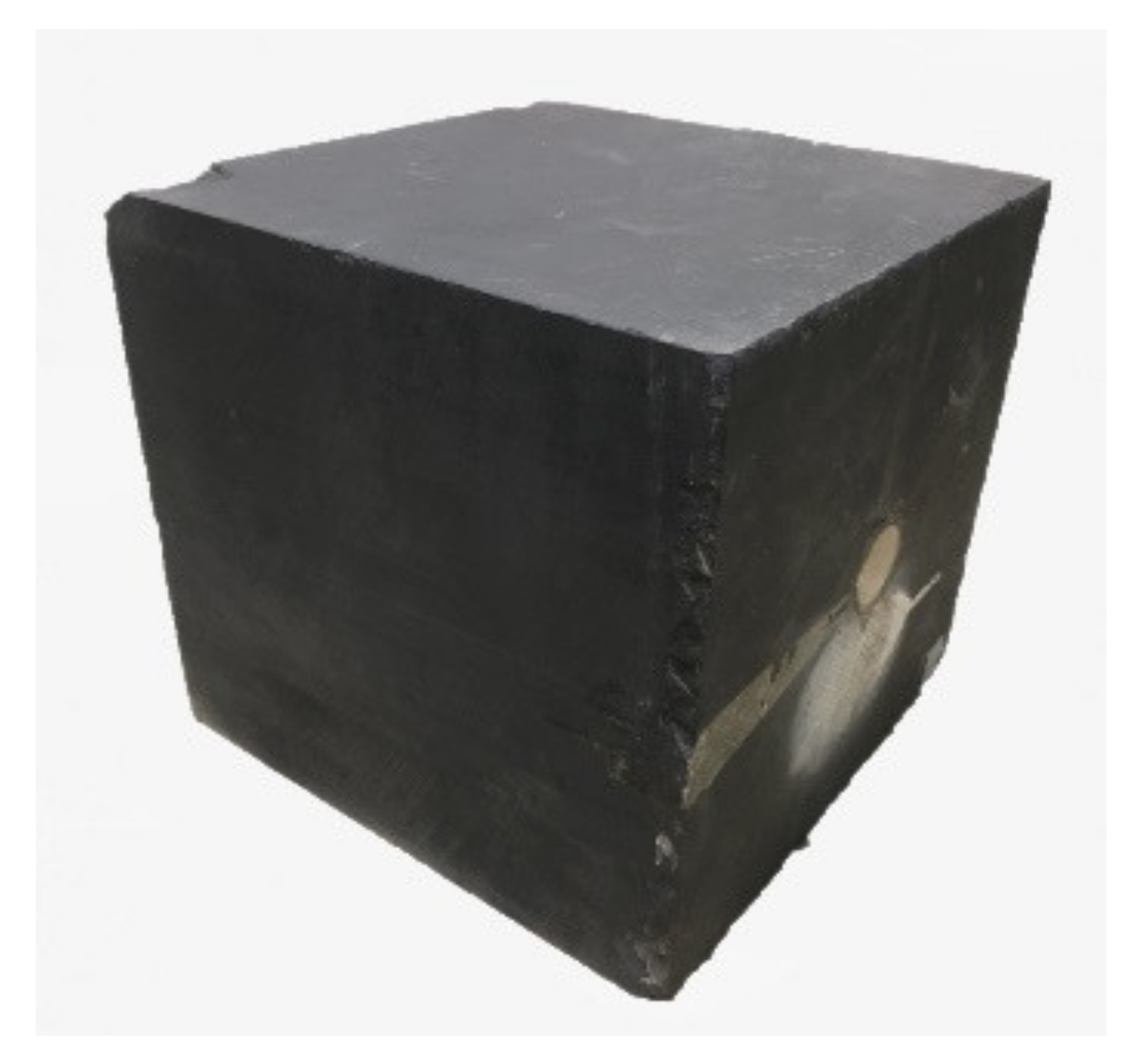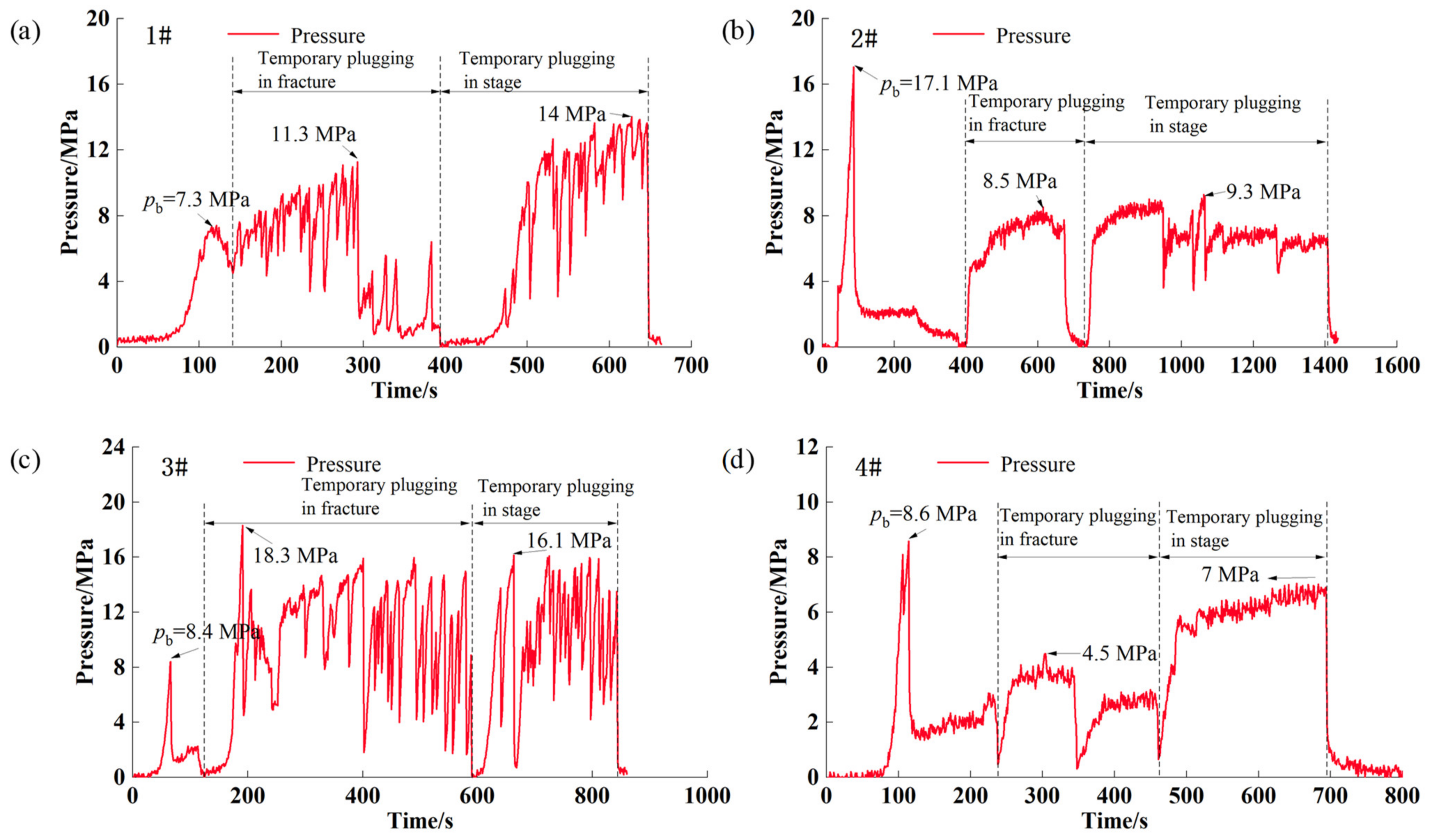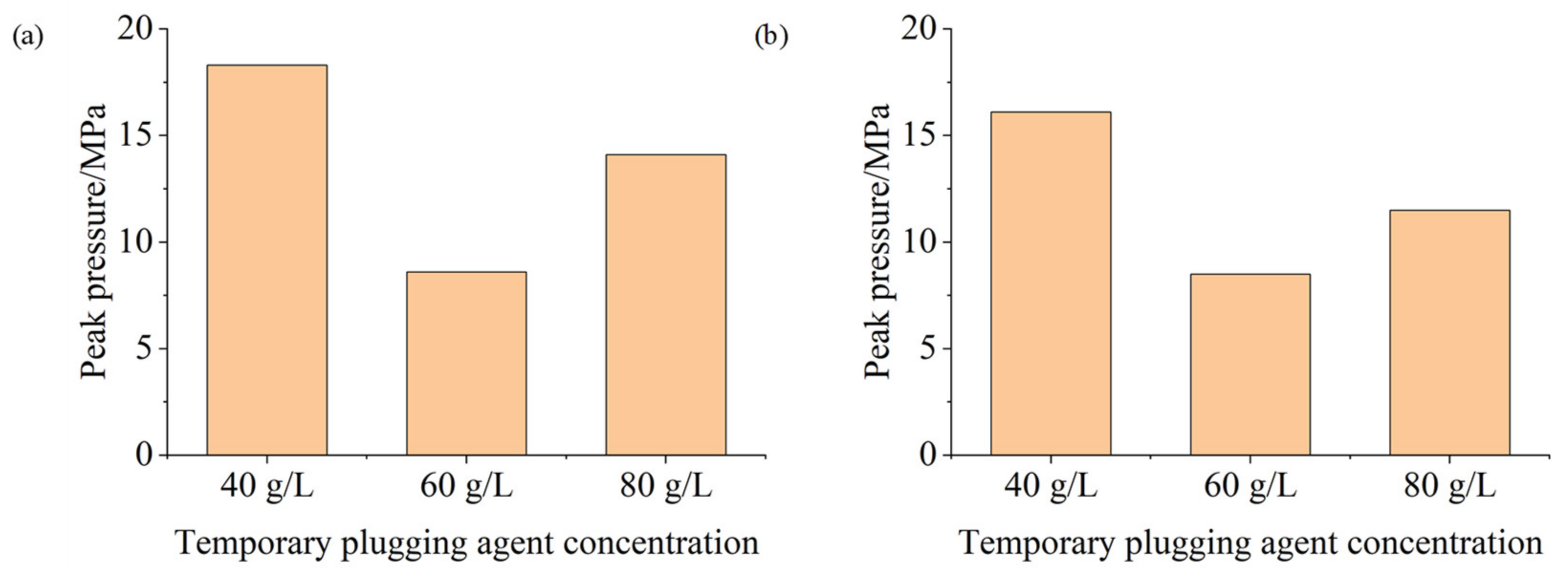Experimental Investigation of the Growth Law of Multi-Fracture during Temporary Plugging Fracturing within a Stage of Multi-Cluster in a Horizontal Well
Abstract
:1. Introduction
2. Experimental Methods
2.1. Specimen Preparation
2.2. Experimental Instruments and Procedures
- Connect the pipelines and put the rock specimen into the pressurization chamber of the experimental system by making the wellbore axis consistent with the X-axis.
- Push the hydraulic piston into the chamber along the X-axis. Following that, apply the vertical stress σv along the Z-axis, and increase the horizontal maximum principal stress σH and horizontal minimum principal stress σh along the Y- and X-axes to the preset value. Meanwhile, the tri-axial stresses were maintained stable.
- Connect the injection pipe inside the simulated wellbore to the six-way valve, and connect the intermediate container containing the fracturing fluid to the six-way valve.
- Open the valve corresponding to the pipeline of the fracturing stage with no temporary plugging agents added, and also open the valve corresponding to the intermediate container, meanwhile keeping the other valves closed. Turn on the fluid injection system and pump the fracturing fluid into the wellbore at a constant rate to commence the primary fracturing experiment. During the primary fracturing, the pressure transducer is used to record the wellhead pressure change until the designed fluid volume is injected. Stop the pump when the pressure stabilizes and close the valve of the corresponding injection pipeline.
- Afterward, clean the intermediate container and pour into the prepared fracturing fluid containing the temporary plugging agents. Then, the intrafracture and intrastage temporary plugging fracturing experiments were carried out. Repeat the operations in step 4 to complete the temporary plugging fracturing experiments mentioned above.
- After the experiment, take out the rock specimen. The hydraulic fractures created from the corresponding stage are identified according to colors of the dye agents on the fracture surfaces, and the fracture propagation trajectories formed during the temporary plugging fracturing were analyzed. The fracture geometry of the sample by CT scanning technology were obtained, and we used SolidWorks to make 3D reconstruction images.

2.3. Experimental Parameters
3. Characterization of Fracture Propagation Geometry
3.1. The Influence of Particle Size Combination
3.2. The Influence of Temporary Plugging Agent Concentration
3.3. The Influence of the Cluster Number in a Stage
4. The Evaluation on Effectiveness of Temporary Plugging
4.1. The Influence of Particle Size Combination
4.2. The Influence of Temporary Plugging Agent Concentration
4.3. The Influence of the Cluster Number in a Stage
5. Conclusions
- Increasing the proportion of the temporary plugging agent of a larger particle size can improve the effectiveness of intrafracture and intrastage temporary plugging fracturing, and tends to open new fractures. More fractures can be produced by using the combinations of 100 mesh to 20/70 mesh and 20/70 mesh to 10~18 mesh temporary plugging agents for the intrafracture and intrastage temporary plugging, respectively.
- Increasing the concentration of the temporary plugging agent and increasing clusters in a single stage can improve the effectiveness of the intrafracture and intrastage temporary plugging, resulting in a more fracture complexity.
- After fracturing, the rock specimens with a high peak in the temporary plugging pressure curve have more transverse fractures, indicating a desirable diversion effect. By contrast, the fractured rock specimen with a low peak pressure has no transverse fracture, generally with fewer fractures and poor diversion effect.
Author Contributions
Funding
Informed Consent Statement
Data Availability Statement
Conflicts of Interest
References
- Liu, X.J.; Liang, L.X.; Cheng, Z.; Liu, Z.J.; Ye, Z.B.; Li, Y. Influence of critical fluid pressure for fracture closure on oil and gas field development. Nat. Gas Ind. 2005, 25, 2. [Google Scholar]
- Taleghani, A.D.; Cai, Y.; Pouya, A. Fracture closure modes during flowback from hydraulic fractures. Int. J. Numer. Anal. Methods Geomech. 2020, 44, 1695–1704. [Google Scholar]
- Wang, T.; Chen, M.; Li, L.C.; Wu, J.; Lu, J.K.; Chang, Z.; Fan, M.; Geng, Z. Experimental Study on Improving Complexity of Hydraulic Fracture Geometry in Reservoirs with Large Horizontal Stress Difference. In Proceedings of the 52nd US Rock Mechanics/Geomechanics Symposium, Seattle, WA, USA, 17–20 June 2018; American Rock Mechanics Association: Alexandria, VA, USA, 2018. [Google Scholar]
- Lu, C.; Luo, Y.; Li, J.F.; Chen, C.; Xiao, Y.J.; Liu, W.; Lu, H.G.; Guo, J.C. Numerical Analysis of Complex Fracture Propagation Under Temporary Plugging Conditions in a Naturally Fractured Reservoir. SPE Prod. Oper. 2020, 35, 0775–0796. [Google Scholar]
- Wang, Y.; Zhou, C.L.; Zhang, H.L.; He, T.T.; Tang, X.Y.; Peng, H.A.; Fang, H.M.; Luo, L.; Gang, S. Research and Application of Segmented Acid Fracturing Technology in Horizontal Wells of Ultra Deep Carbonate Gas Reservoirs in Southwest China. In Proceedings of the International Petroleum Technology Conference, Virtual. 23 March–1 April 2021. [Google Scholar]
- Lin, C.; Kang, Y.L.; Xu, C.Y.; You, L.J.; Zhang, Z.; Tan, Q.G. An Engineered Formation-Damage-Control Drill-In Fluid Technology for Deep-Fractured Tight-Sandstone Oil Reservoir in Northern Tarim Basin. SPE Drill. Completion 2020, 35, 26–37. [Google Scholar]
- Zhu, D.Y.; Xu, Z.H.; Sun, R.X.; Fang, X.Y.; Gao, D.W.; Jiang, X.B.; Hu, J.R.; Weng, J.T. Laboratory evaluation on temporary plugging performance of degradable preformed particle gels (DPPGs). Fuel 2021, 289, 119743. [Google Scholar]
- Hou, B.; Fu, W.N.; Han, H.F.; Min, J.; Chen, A. The Effect of Temporary Plugging Agents and Pump Rate on Fracture Propagation in Deep Shale Based on True Tri-Axial Experiments. In Proceedings of the 54th US Rock Mechanics/Geomechanics Symposium, Online, 28 June–1 July 2020; American Rock Mechanics Association: Alexandria, VA, USA, 2020. [Google Scholar]
- Xue, S.J.; Zhang, Z.Y.; Wu, G.T.; Wang, Y.X.; Wu, J.; Xu, J.H. Application of a Novel Temporary Blocking Agent in Refracturing. In Proceedings of the SPE Asia Pacific Unconventional Resources Conference and Exhibition, Brisbane, Australia, 9–11 November 2015. [Google Scholar]
- LWang, W.; Han, X.L.; Xiong, C.M.; Wang, B.; Yang, Z.W.; Gao, Y. Multi-Fracture Temporary Blocking Steering Mechanism and Experimental Research in Ultra-Deep Fractured Reservoir. In Proceedings of the 5th ISRM Young Scholars’ Symposium on Rock Mechanics and International Symposium on Rock Engineering for Innovative Future, Okinawa, Japan, 1–4 December 2019. [Google Scholar]
- Fan, S.L.; Wang, X.F.; Dong, J.; You, Q.Y.; Yang, X.C.; Zhao, J.F. Research of Formation Protection Technology in Complex Fault Block Oilfield. In Proceedings of the International Petroleum Technology Conference, Beijing, China, 26–28 March 2019. [Google Scholar]
- Jin, Z.R.; Wu, L.; He, T.S.; Zhou, X.; Yu, Y. Optimization and Application of Composite Temporary Blocking Agent for Divert Fractureing. Drill. Prod. Technol. 2019, 42, 54–57. [Google Scholar]
- Xiong, C.M.; Shi, Y.; Zhou, F.J.; Liu, X.F.; Yang, X.Y.; T, X. Yang, High efficiency reservoir stimulation based on temporary plugging and diverting for deep reservoirs. Pet. Explor. Dev. 2018, 45, 948–954. [Google Scholar]
- Zhang, R.X.; Hou, B.; Tan, P.; Muhadast, Y.; Fu, W.N.; Dong, X.M.; Chen, M. Hydraulic fracture propagation behavior and diversion characteristic in shale formation by temporary plugging fracturing. J. Pet. Sci. Eng. 2020, 190, 107063. [Google Scholar]
- Liu, S.; Guo, T.K.; Rui, Z.H.; Ling, K.G. Performance Evaluation of Degradable Temporary Plugging Agent in Laboratory Experiment. J. Energy Resour. Technol. 2020, 142, 1–11. [Google Scholar]
- Xiao, B.; Jiang, T.X.; Ding, S.D.; Chen, Z.; Zhang, X.D.; Li, K.D. Research on temporary plugging refracturing technology for shale gas wells. IOP Conf. Ser. Earth Environ. Sci. 2020, 510, 022023. [Google Scholar]
- Zou, Y.S.; Ma, X.F.; Zhang, S.C. Numerical modeling of fracture propagation during temporary plugging fracturing. SPE J. 2020, 25, 1503–1521. [Google Scholar]
- Chen, M.; Zhang, S.C.; Zhou, T.; Zou, Y.S. Optimization of In-Stage Diversion to Promote Uniform Planar Multi-Fracture Propagation: A Numerical Study. SPE J. 2020, 25, 3091–3110. [Google Scholar]
- Shi, S.Z.; Cheng, F.S.; Wang, M.X.; Wang, J.; Lv, W.J.; Wang, B. Hydrofracture plugging mechanisms and evaluation methods during temporary plugging and diverting fracturing. Energy Sci. Eng. 2022, 10, 790–799. [Google Scholar] [CrossRef]
- Chen, J.M.; Zhang, Q.; Zhang, J.C. Numerical Simulations of Temporary Plugging-Refracturing Processes in a Conglomerate Reservoir Under Various In-Situ Stress Difference Conditions. Front. Phys. 2022, 9, 826605. [Google Scholar]
- Fan, Y.; Zhang, H.; Zhang, J.; Song, Y.; Zhong, Y. Experimental Study on Synergistic Application of Temporary Plugging and Propping Technologies in SRV Fracturing of Gas Shales. Chem. Technol. Fuels Oils 2021, 57, 311–323. [Google Scholar]
- Hao, T.; Qu, Z.Q.; Guo, T.K.; Chen, M.; Qi, N.; Ge, J.J.; Mu, S.B.; Xiao, X.L. A Novel Fracturing Technology with Significant Downward Propagation of Fracture in Ultra-deep Reservoir. In Proceedings of the ARMA/DGS/SEG 2nd International Geomechanics Symposium, Online. 1–4 November 2021. [Google Scholar]
- Li, S.H.; Zhang, S.C.; Zou, Y.S.; Zhang, X.; Ma, X.F.; Wu, S.; Zhang, Z.P.; Sun, Z.Y.; Liu, C.Y. Experimental study on the feasibility of supercritical co2-gel fracturing for stimulating shale oil reservoirs. Eng. Fract. Mech. 2020, 238, 107276. [Google Scholar]
- Zhang, Z.P.; Zhang, S.C.; Zou, Y.S.; Ma, X.F.; Li, N.; Liu, L. Experimental investigation into simultaneous and sequential propagation of multiple closely spaced fractures in a horizontal well. J. Pet. Sci. Eng. 2021, 202, 108531. [Google Scholar]
- Zou, Y.S.; Ma, X.F.; Zhou, T.; Li, N.; Chen, M.; Li, S.H.; Zhang, Y.N.; Li, H. Hydraulic fracture growth in a layered formation based on fracturing experiments and discrete element modeling. Rock Mech. Rock Eng. 2017, 50, 2381–2395. [Google Scholar]
- Zou, Y.S.; Li, N.; Ma, X.F.; Zhang, S.C.; Li, S.H. Experimental study on the growth behavior of supercritical co 2 -induced fractures in a layered tight sandstone formation. J. Nat. Gas Sci. Eng. 2018, 49, 145–156. [Google Scholar]
- Zou, Y.S.; Zhang, S.C.; Zhou, T.; Zhou, X.; Guo, T.K. Experimental investigation into hydraulic fracture network propagation in gas shales using CT scanning technology. Rock Mech. Rock Eng. 2016, 49, 33–45. [Google Scholar]
- Li, N.; Zhang, S.C.; Zou, Y.S.; Ma, X.F.; Wu, S.; Zhang, Y.N. Experimental analysis of hydraulic fracture growth and acoustic emission response in a layered formation. Rock Mech. Rock Eng. 2018, 51, 1047–1062. [Google Scholar]
- Li, N.; Zhang, S.C.; Zou, Y.S.; Ma, X.F.; Zhang, Z.P.; Li, S.H.; Chen, M.; Sun, Y.Y. Acoustic emission response of laboratory hydraulic fracturing in layered shale. Rock Mech. Rock Eng. 2018, 51, 3395–3406. [Google Scholar]
- Chen, J.L.; Wang, Y.; Zhao, X.B.; Tang, C.Y.; Gao, Y.; Zhou, D.; Zeng, B.; Liu, X.P.; Li, W.H.; Wu, J.P.; et al. Chemical Agents Diversion with Microseismic Monitoring-New Prospects of Refracturing for Open-Hole Horizontal Well in Tight Oil Reservoir of Junggar Basin, China. In Proceedings of the SPE/IATMI Asia Pacific Oil & Gas Conference and Exhibition, Bali, Indonesia, 29–31 October 2019. [Google Scholar]
- Zou, J.; Wang, Y.G.; Wu, L.L.; Yang, X.; Wang, R.F.; Meng, Q.C.; Jiang, W.X.; Wang, S.L.; Li, S.; Li, S.; et al. Research and Application of Retreatment Technology to Tap Remaining Oil in Chang Qing Low Permeability Oilfield. In Proceedings of the International Petroleum Technology Conference, Beijing, China, 26–28 March 2019. [Google Scholar]
- Wang, Y.; Zhao, X.B.; Shang, J.L.; Tang, C.Y.; Deng, J.S.; Xing, X.Y. Novel Technology to Improve Recovery of Remaining Oil in Tight Glutenite Reservoir of Junggar Basin: Employing Chemical Diverting Agents in Refracturing Operation. In Proceedings of the Abu Dhabi International Petroleum Exhibition & Conference, Abu Dhabi, United Arab Emirates, 9–12 November 2020. [Google Scholar]
- Zhang, L.F.; Zhou, F.J.; Feng, W.; Cheng, J.Q. Temporary Plugging Mechanism of Degradable Diversion Agents within Reproduced Acid-Etched Fracture by Using 3D Printing Model. In Proceedings of the Abu Dhabi International Petroleum Exhibition & Conference, Abu Dhabi, United Arab Emirates, 11–14 November 2019. [Google Scholar]











| Coring Direction | Young’s Modulus (GPa) | Poisson’s Ratio | Compressive Strength (MPa) | Tensile Strength (MPa) |
|---|---|---|---|---|
| Parallel to bedding planes | 47.2 | 0.275 | 392 | 9.12 |
| Vertical to bedding planes | 39.3 | 0.257 | 301.9 | 11.20 |
| Specimen No. | Plugging Agents for Intrafracture Temporary Plugging (2 L Fracturing Fluid in Each Test) | Plugging Agents for Intrastage Temporary Plugging (2 L Fracturing Fluid in Each Test) | Cluster Number | ||||||
|---|---|---|---|---|---|---|---|---|---|
| Type 1 | Type 2 | Type 1 | Type 2 | ||||||
| Quality (g) | Particle Size (Mesh) | Quality (g) | Particle Size (Mesh) | Quality (g) | Particle Size (Mesh) | Quality (g) | Particle Size (Mesh) | ||
| 1# | 60 | 200–300 | 20 | 20–70 | 40 | 20–70 | 20 | 10–18 | 7 |
| 2# | 60 | 200–300 | 20 | 100 | 40 | 200–300 | 20 | 100 | 7 |
| 3# | 20 | 100 | 60 | 20–70 | 40 | 20–70 | 20 | 10–18 | 7 |
| 4# | 60 | 100 | 20 | 20–70 | 40 | 100 | 20 | 20–70 | 7 |
| 5# | 60 | 100 | 20 | 20–70 | 40 | 20–70 | 20 | 10–18 | 3 |
| 6# | 60 | 100 | 20 | 20–70 | 40 | 20–70 | 20 | 10–18 | 7 |
| 7# | 100 | 100 | 60 | 20–70 | 80 | 20–70 | 60 | 10–18 | 7 |
| 8# | 60 | 100 | 20 | 20–70 | 40 | 20–70 | 20 | 10–18 | 5 |
| 9# | 60 | 100 | 20 | 20–70 | 40 | 20–70 | 20 | 10–18 | 9 |
Publisher’s Note: MDPI stays neutral with regard to jurisdictional claims in published maps and institutional affiliations. |
© 2022 by the authors. Licensee MDPI, Basel, Switzerland. This article is an open access article distributed under the terms and conditions of the Creative Commons Attribution (CC BY) license (https://creativecommons.org/licenses/by/4.0/).
Share and Cite
Li, Y.; Zhang, Q.; Zou, Y. Experimental Investigation of the Growth Law of Multi-Fracture during Temporary Plugging Fracturing within a Stage of Multi-Cluster in a Horizontal Well. Processes 2022, 10, 637. https://doi.org/10.3390/pr10040637
Li Y, Zhang Q, Zou Y. Experimental Investigation of the Growth Law of Multi-Fracture during Temporary Plugging Fracturing within a Stage of Multi-Cluster in a Horizontal Well. Processes. 2022; 10(4):637. https://doi.org/10.3390/pr10040637
Chicago/Turabian StyleLi, Yanchao, Qing Zhang, and Yushi Zou. 2022. "Experimental Investigation of the Growth Law of Multi-Fracture during Temporary Plugging Fracturing within a Stage of Multi-Cluster in a Horizontal Well" Processes 10, no. 4: 637. https://doi.org/10.3390/pr10040637





